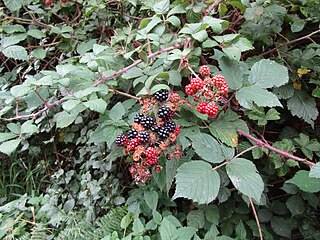
Rubus is a large and diverse genus of flowering plants in the rose family, Rosaceae, subfamily Rosoideae, with over 1,350 species, commonly known as brambles.

Amelanchier, also known as shadbush, shadwood or shadblow, serviceberry or sarvisberry, juneberry, saskatoon, sugarplum, wild-plum or chuckley pear, is a genus of about 20 species of deciduous-leaved shrubs and small trees in the rose family (Rosaceae).

The Elaeagnaceae are a plant family, the oleaster family, of the order Rosales comprising small trees and shrubs, native to temperate regions of the Northern Hemisphere, south into tropical Asia and Australia. The family has about 60 species in three genera.

Sambucus is a genus of flowering plants in the family Adoxaceae. The various species are commonly referred to as elder, elderflower or elderberry.

Cornus is a genus of about 30–60 species of woody plants in the family Cornaceae, commonly known as dogwoods, which can generally be distinguished by their blossoms, berries, and distinctive bark. Most are deciduous trees or shrubs, but a few species are nearly herbaceous perennial subshrubs, and some species are evergreen. Several species have small heads of inconspicuous flowers surrounded by an involucre of large, typically white petal-like bracts, while others have more open clusters of petal-bearing flowers. The various species of dogwood are native throughout much of temperate and boreal Eurasia and North America, with China, Japan, and the southeastern United States being particularly rich in native species.

Aronia is a genus of deciduous shrubs, the chokeberries, in the family Rosaceae native to eastern North America and most commonly found in wet woods and swamps. The genus Aronia is considered to have 3 species. The most common and widely used is Aronia melanocarpa which emerged from Eastern North America. The lesser known Aronia arbutifolia and the hybrid form of the abovementioned species called Aronia prunifolia were first cultivated in Central and Eastern North America. In the eighteenth century, the first shrubs of the best-known species Aronia melanocarpa reached Europe where they were first cultivated in Scandinavia and Russia.
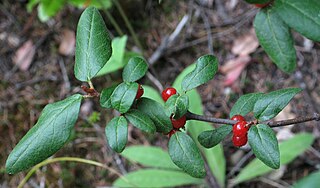
Shepherdia canadensis, commonly called Canada buffaloberry, russet buffaloberry, soopolallie, soapberry, or foamberry is one of a small number of shrubs of the genus Shepherdia that bears edible berries.

Tsuga canadensis, also known as eastern hemlock, eastern hemlock-spruce, or Canadian hemlock, and in the French-speaking regions of Canada as pruche du Canada, is a coniferous tree native to eastern North America. It is the state tree of Pennsylvania. Eastern hemlocks are widespread throughout much of the Great Lakes region, the Appalachian Mountains, the Northeastern United States, and Maritime Canada. They have been introduced in the United Kingdom and mainland Europe, where they are used as ornamental trees.
Soapberry is a common name for several plants and may refer to:

Taxus canadensis, the Canada yew or Canadian yew, is a conifer native to central and eastern North America, thriving in swampy woods, ravines, riverbanks and on lake shores. Locally called simply "yew", this species is also referred to as American yew or ground-hemlock.
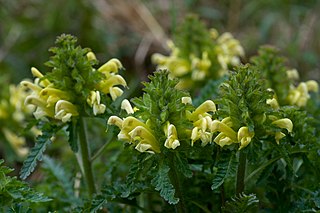
Pedicularis canadensis, commonly called Canadian lousewort or wood betony, is a flowering plant in the family Orobanchaceae. It is native to North America, where it is found in southeastern Canada, the eastern United States, and eastern Mexico. It has a wide-ranging natural habitat, being found in mesic to dry, forests, woodlands, and prairies.
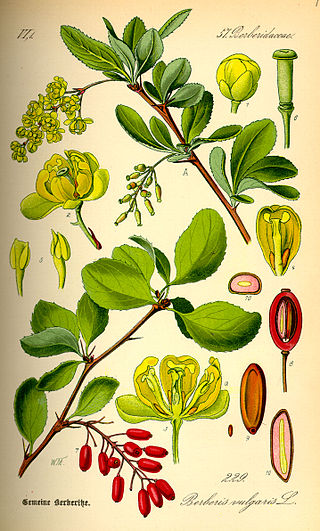
Berberis vulgaris, also known as common barberry, European barberry or simply barberry, is a shrub in the genus Berberis native to the Old World. It produces edible but sharply acidic berries, which people in many countries eat as a tart and refreshing fruit.

Solidago canadensis, known as Canada goldenrod or Canadian goldenrod, is an herbaceous perennial plant of the family Asteraceae. It is native to northeastern and north-central North America and often forms colonies of upright growing plants, with many small yellow flowers in a branching inflorescence held above the foliage. It is an invasive plant in other parts of the continent and several areas worldwide, including Europe and Asia. It is grown as an ornamental in flower gardens.

Shepherdia argentea, commonly called silver buffaloberry, bull berry, or thorny buffaloberry, is a species of Shepherdia in the Oleaster family.

Rubus pubescens is a herbaceous perennial widespread across much of Canada and the northern United States, from Alaska to Newfoundland, south as far as Oregon, Colorado, and West Virginia.
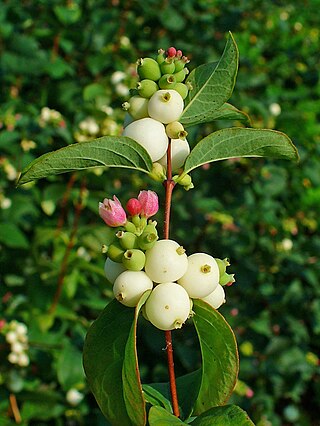
Symphoricarpos albus is a species of flowering plant in the honeysuckle family known by the common name common snowberry. Native to North America, it is browsed by some animals and planted for ornamental and ecological purposes, but is poisonous to humans.
Leymus innovatus is a species of grass known as downy ryegrass, boreal wildrye, hairy wildrye, fuzzyspike wildrye, northern wildrye, and northwestern wildrye. It is native to northern North America from Alaska to eastern Canada and south to Colorado.
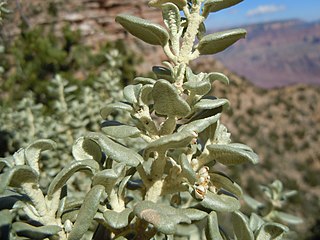
Shepherdia rotundifolia, the roundleaf buffaloberry or silverleaf, is a 3-to-6-foot (1-to-2-meter) evergreen shrub in the oleaster family (Elaeagnaceae) that grows only in the Colorado Plateau (endemic) of the southwestern United States. The common name comes from western settlers using the cooked berries in a sauce for eating cooked buffalo meat.
Xylena cineritia, the gray swordgrass moth, is a species of cutworm or dart moth in the family Noctuidae. It is found in northern North America, from New Jersey to Newfoundland and from California to British Columbia.
















